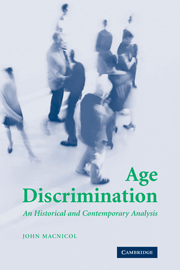Book contents
- Frontmatter
- Contents
- List of figures
- List of tables
- Acknowledgements
- Part I Ageism and Age Discrimination
- Part II The Current Revival of Interest in Britain
- 3 New Labour and age discrimination
- Part III Retirement, health status and work-disability
- Part IV America's Age Discrimination in Employment Act
- Bibliography
- Index
3 - New Labour and age discrimination
Published online by Cambridge University Press: 24 August 2009
- Frontmatter
- Contents
- List of figures
- List of tables
- Acknowledgements
- Part I Ageism and Age Discrimination
- Part II The Current Revival of Interest in Britain
- 3 New Labour and age discrimination
- Part III Retirement, health status and work-disability
- Part IV America's Age Discrimination in Employment Act
- Bibliography
- Index
Summary
Introduction
Age discrimination has once again become a topic of public debate in Britain. The period since the late 1980s has witnessed the emergence of a ‘new retirement agenda’, the essential component parts of which are the renewed concerns over a future ageing population, the ticking ‘timebomb’ of state pension funding, the growth of male ‘early’ retirement, and an overall redefinition of old age. Intriguingly, these economic concerns have been paralleled by an emerging postmodern sociology of old age which suggests that the lifecourse is becoming more ‘blurred’, that society will become more ‘ageless’ and that ‘positive ageing’ or ‘active ageing’ will increasingly be a social aim. Pathways into retirement are becoming increasingly complex, diverse and multi-layered, and retirement itself may be becoming ‘deinstitutionalised’. Rightly, Chris Phillipson has observed that these combined tendencies constitute ‘a historic turning-point in the debate about the character and significance of ageing populations’. Central to this new agenda is the question of whether older people should remain in paid employment for longer. If so, those ‘age discriminatory’ barriers to their economic activity should be identified and removed.
The policy background
Since the early 1990s, British governments have become increasingly concerned about the problems of older workers. During John Major's Conservative administrations (1990–7) there was growing activity within the Department of Employment (later Department for Education and Employment). In 1993 a campaign was launched to educate employers in the value of older workers, via the booklet Getting On.
- Type
- Chapter
- Information
- Age DiscriminationAn Historical and Contemporary Analysis, pp. 71 - 118Publisher: Cambridge University PressPrint publication year: 2006



